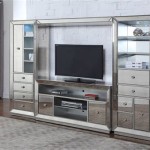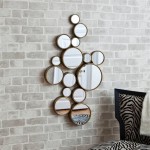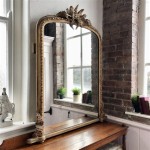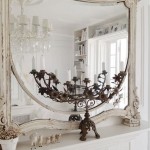Clips to Hold Mirror on Wall
Mirrors play a significant role in interior design, enhancing light and creating the illusion of space. Securely mounting a mirror on the wall is crucial for both safety and aesthetics. While traditional methods like adhesives and screws remain popular, mirror clips offer a versatile and often simpler alternative. This article will explore the various types of mirror clips available, their installation processes, and factors to consider when choosing the right clips for a specific mirror.
Mirror clips are broadly categorized into two main types: fixed clips and adjustable clips. Fixed clips grip the mirror firmly in a stationary position. These clips are ideal for mirrors that require a tight fit against the wall and offer a clean, minimalist look. They are typically used for smaller, lighter mirrors where minor adjustments are unnecessary. Adjustable clips, on the other hand, allow for fine-tuning after installation. This feature is particularly useful for larger, heavier mirrors that may require leveling or slight positional adjustments. Adjustable clips often incorporate screws or other mechanisms that allow for precise positioning of the mirror.
Several materials are commonly used in the manufacturing of mirror clips. Metal clips, often made of stainless steel or brass, are known for their durability and strength. These clips can support substantial weight and are less susceptible to corrosion or wear over time. Plastic clips are a lightweight and cost-effective option, suitable for smaller, lighter mirrors. While plastic clips may not offer the same load-bearing capacity as metal clips, they are often easier to install and are available in a variety of colors to match the mirror frame or surrounding décor. Some clips combine materials, incorporating a metal base for strength with a plastic or rubberized coating to protect the mirror's edges from scratches.
The size and shape of the mirror clip should be chosen based on the dimensions and thickness of the mirror. Clips designed for thin mirrors may not provide adequate support for thicker, heavier ones. Similarly, using oversized clips on a small mirror can appear visually unappealing. Manufacturers typically provide specifications regarding the suitable mirror thickness for each clip type. It's crucial to adhere to these recommendations to ensure a secure and aesthetically pleasing installation.
The installation process for mirror clips typically involves several steps. First, the desired location for the mirror should be marked on the wall. It's important to ensure that the wall surface is clean and free from any debris that could interfere with adhesion or drilling. Next, the clips are positioned according to the manufacturer's instructions and secured to the wall using appropriate fasteners. The type of fastener required will depend on the wall material and the weight of the mirror. Once the clips are securely attached, the mirror can be carefully placed into the clips, ensuring it fits snugly and securely. For adjustable clips, final adjustments can be made to ensure the mirror is level and positioned correctly.
Prior to purchasing mirror clips, it is important to consider several factors. The weight and dimensions of the mirror are paramount in determining the appropriate clip size and material. Heavier mirrors necessitate stronger, more robust clips. The type of wall material also plays a role in selecting the correct fasteners. Drywall, for instance, requires different anchors than concrete or brick walls. The desired aesthetic is another consideration. Some clips are designed to be discreet, blending seamlessly with the mirror frame, while others offer a more decorative element. Finally, the budget allocated for the project can influence the choice of material and design. While metal clips tend to be more expensive than plastic ones, they offer greater durability and load-bearing capacity.
Beyond the basic function of securing a mirror, certain mirror clips incorporate additional features. Some clips include anti-vibration pads to minimize movement and prevent the mirror from rattling against the wall. This feature can be particularly beneficial in high-traffic areas or environments prone to vibrations. Other clips offer built-in leveling mechanisms, simplifying the installation process and ensuring a perfectly aligned mirror. Some manufacturers also offer specialized clips designed for specific mirror shapes, such as round or oval mirrors. These specialized clips provide a more secure and tailored fit.
Maintaining the appearance and functionality of mirror clips is straightforward. Regular cleaning with a damp cloth can remove dust and grime, preventing buildup that could affect the clip's grip. For metal clips, periodic inspection for signs of corrosion or damage is recommended. If any damage is detected, the clips should be promptly replaced to ensure the mirror's continued secure mounting. Avoid using abrasive cleaners or harsh chemicals, as these can damage the clip's finish or weaken the material.
Choosing the right mirror clips is essential for ensuring a secure and aesthetically pleasing installation. By carefully considering factors such as mirror weight, wall material, and desired aesthetic, one can select the appropriate clips for the specific application. Proper installation and regular maintenance will contribute to the longevity and functionality of the clips, keeping the mirror securely in place for years to come.

How To Frame A Mirror With Clips In 5 Easy Steps

How I Installed A Really Big Mirror Merrypad Diy Network

Clips Mirrors Mirror Accessories At Com

How To Frame A Bathroom Mirror Over Plastic Clips Somewhat Simple

4 Pack Or 50 Clear Plastic Mirror Mount Clips Glass Singapore

How To Frame A Bathroom Mirror Over Plastic Clips Somewhat Simple

How To Hang A Frameless Mirror On The Wall With Pictures

How To Hang A Mirror With Clips

How I Installed A Really Big Mirror Merrypad Diy Network

Diy Bathroom Mirror Frame Without Removing Clips Her Happy Home








